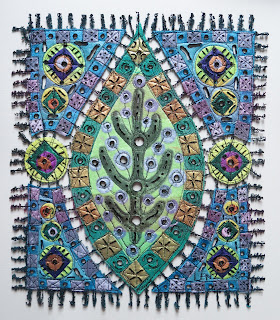I first saw this wedding gown when my friend Ellen Kochansky hung it in her solo show at 701 CCA back in 2009. It was fragile then but also simply gorgeous. Ellen used it once again in a later place. The condition only worsened.
Recently, Ellen gave the gown to me. It was no longer in a condition that would allow it to hang. The pleated bodice, puffy sleeves, and the ruffles that were to peek through hemline slits are all but disintegrating. The lacy middle panel needed to be totally reconstructed ... but I still adored this gown. It spoke of history and preciousness and wedding vows. Still ... I wasn't sure if I could actually use it for anything at all despite my desire to "give it a second life" (or in this case a third or fourth or fifth ... depending on just how many generations loved and wore it!)
I googled for Chat GPT. I asked it to write a short story in the voice of an 1860s, handmade Swiss wedding dress that was sent to NYC and worn through generations until Susan Lenz transformed it into an art quilt. I had no hope for anything worth reading. It took a matter of two or three seconds before these charming words appeared on my computer screen:
I was born in Switzerland in 1860, stitched from smooth ivory satin and sent across the ocean to New York. Anna first wore me on a crisp autumn morning, my fabric rustling as she whispered, Yes, I will. I felt her joy, the warmth of her groom’s hand, the sway of their first dance.
Folded away, I emerged for Anna’s daughter, then her granddaughter. Each bride altered me slightly, but I remained, wrapping new hearts in love. Time wore me thin—a stain from a toast, a tear from an embrace. By 1942, young Margaret wore me as war loomed, clinging to love amid uncertainty.
Now, I am no longer whole, but I am not forgotten. In Susan Lenz’s hands, I will live again—not as a gown, but as an art quilt, stitched with the memories of generations, a testament to love that never fades.
Again, I was stunned. How utterly lovely. I started free-motion stitching this bit of fiction (based on the few facts I knew!) onto a piece of vintage damask sandwiched with some cotton batting. Then, I taped a larger piece of batting to my floor. Over it, I lay the rest of the damask tablecloth. The trailing back of the gown was trimmed off. Most of the back was cut away. An arrangement started to materialize.
(Above: The Gown's Story in progress.)My original plan was to baste the dress and the words to the damask and then stitch a layer of ivory bridal tulle/netting over the top. The netting was supposed to protect the fragile fabric, prevent any flaking satin from falling away. My plan just didn't work. First, basting gave way to lots and lots of tiny hand-stitching to keep the garment as flat as possible and to adequately attach it to the damask. Second, the netting just couldn't stretch enough over the dress and still remain flat over the rest of the piece. There was nothing to do but to move on to Plan B.
Plan B required hundreds and hundreds of tiny stitching. The dress, once firmly attached to the underlying damask tablecloth and batting, was covered with the ivory tulle. The tulle was hand-stitched to the edges and along every row of lace in the center panel. It was stitched around all the hemline slits, the entire bodice, the sleeves, the glove, etc. Once finished, I free-motion machine stitched around the perimeter and cut the garment out ... effectively creating a giant "patch". This was the only way I could think of to protect the fragile material and keep the thing relatively flat.
I knew that if I attempted to attach this "patch" to another layered/quilted piece of fabric, it probably wouldn't hang straight. It would end up hanging in some distorted manner. So ... I had Steve build me a 60" x 44" stretcher bar. I stapled an over-sized piece of acid-free foamcore to the stretcher bar. Cotton batting and another damask tablecloth were stretched over the surface and stapled to the sides of the stretcher bar. The dress "patch" and the words "patch" were pinned down. Then ... I rigged up a station for more stitching!
Assorted white and off-white buttons were then stitched around the perimeter of the "patched" ... through the edges of the "patches" and through the tablecloth, batting, and the foamcore. Lots of additional stitches were plied to distribute the weight of the garment and firmly attach it to the substrata. It is flat. It hangs without distortion. I love it as much as I did back in 2009.
(Above: Detail of The Gown's Story.)
Today, I entered it into the SAQA AI show. Odds are long for an acceptance but that doesn't matter to me. I am over the moon with the success of transforming this precious dress, giving it a second life. I learned plenty, especially the fact that Chat GPT is my friend.
Initially, I had no interest in using AI or entering this show. But when a friend ran my artist statement through ChatGPT, I was surprised by the results—fluid, insightful, and strangely moving. I wondered what story AI might invent for an 1860s wedding gown recently donated to my stash. One factual prompt produced a vivid fiction. Inspired, I reimagined the gown, stitching it into a new narrative shaped by both hand and machine. The Gown’s Story gives the dress a second life, exploring the intersection of memory, fabrication, and the evolving role of AI in storytelling and art.















.jpeg.jpg)

















